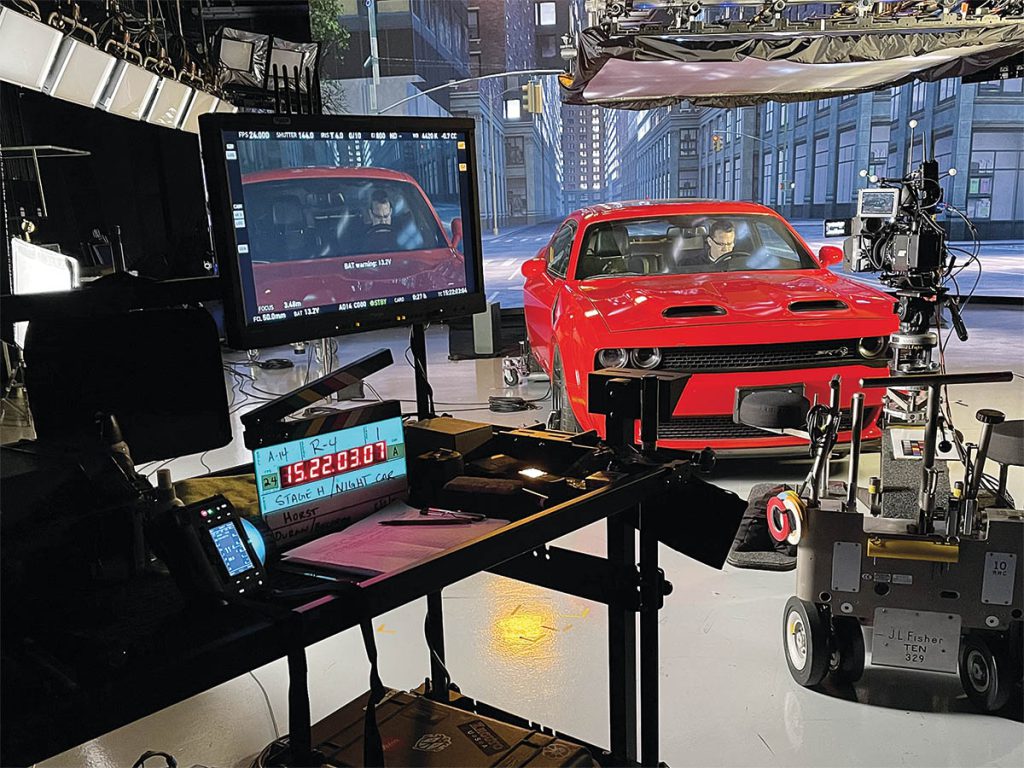By Jeremy Hochman, Megapixel VR, and Chuck Edwards, NBCUniversal
Edited for this publication by Jeffrey A. Okun, VES
Abstracted from The VES Handbook of Virtual Production
Edited by Susan Zwerman, VES and Jeffrey A. Okun, VES
By Jeremy Hochman, Megapixel VR, and Chuck Edwards, NBCUniversal
Edited for this publication by Jeffrey A. Okun, VES
Abstracted from The VES Handbook of Virtual Production
Edited by Susan Zwerman, VES and Jeffrey A. Okun, VES

Figure 23.2 Car process using LED wall and flying LED panels. (Image courtesy of NBC/Universal)
One of the first and most dramatic set designs to explore reflections with virtual production was Oblivion (2013). A futuristic apartment was surrounded by walls of glass revealing a panoramic apocalyptic world. Most impressive was the deliberate reflective nature of furnishings, flooring, and construction materials. Accomplished using projection screens, this groundbreaking film showed how reflections carefully leveraged in VP can amplify the dramatic impact and immersion of the audience into the environment on screen.
The source location of the reflected image is key. The existing LED wall image in the frustum may provide the proper source location. More challenging situations are sets that feature glossy curved shapes like vehicles or other vertical and/or complex curved reflective surfaces. In most cases, the reflections on these will need to come from LED panels that are outside of the frustum. Careful shot planning is needed to provide sources for these reflections and avoid unintentionally capturing the camera and crew on these surfaces.
A common VP scene is a car process shot. After the camera location is selected and the vehicle and LED wall are positioned to accommodate the frustum, an additional flying LED panel is frequently rigged to be hung over the car and positioned at the correct location and angle to create the additional reflections needed. Unlike a simple LED ceiling, these will generally NOT be in a horizontal orientation. These flying LED panels may need to be quite large (10 to 15 feet or more) to provide coverage of the vehicle’s full length to create a complete reflection. Another benefit of flying LED panels is the content and position of the reflections on the vehicle can be adjusted for the camera by repositioning of the panels.
Convex or concave reflective surfaces can act as unintentional optics, in some cases magnifying the reflected image and making the pixels of the LED panels visible in camera, creating a moiré effect in the captured image. Car windshields are a common convex reflection that can create this problem. A proven technique to solve this is the placement of a thin diffuser a few inches in front of the flying LED Panel. This diffuses the LED panel image, eliminating the detail of individual pixels and giving the impression the image is slightly out of focus due to the depth of field. Adding diffusion in front of the panels also enables the use of lower-resolution LED panels with larger pixel spacing without the concern of moiré effects.
For low-detail reflections, consider if stage light(s) may be a better alternative. A simple example is a cop car effect on wet pavement. LED panels do not have the same intensity and beam structure as practical light. A stage light off-camera may do a better job of creating this effect. Creating the reflections of an off-camera overhead sodium vapor streetlight is another example. Several LED light fixtures feature zonal color as well, allowing them to make low-resolution chases and other color patterns. For low-detail situations in VP, these may be better choices than using additional LED panels that may not be able to reproduce the light intensities or beam structure needed for the effect. In many cases, a stage light, or series of stage lights, can provide a better approximation. Another example was a production using LED walls for a car process shot and stage lights directed to light the talent inside the vehicle. The background plate on the LED wall also created direct reflections on the car hood, while the stage lights were used to vary the lighting of the passengers inside the vehicle to reproduce the illusion of changing lighting conditions caused by passing trees, buildings, overpasses and other shadows the vehicle passed through.
Order yours today!